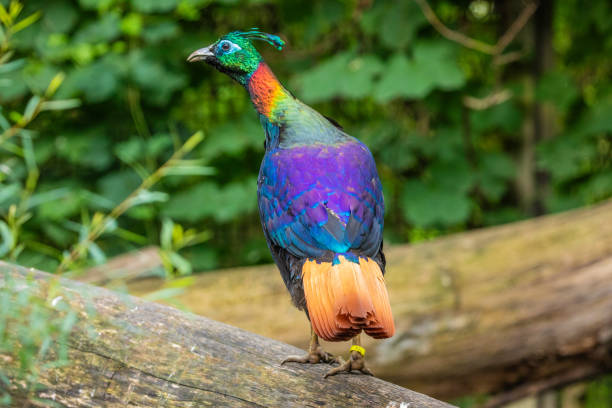Himalayan Monal: Jewel of the Himalayas
Table of Contents
Scientific Classification
| Kingdom | Animalia |
| Phylum | Chordata |
| Class | Aves |
| Order | Galliformes |
| Family | Phasianidae |
| Genus | Lophophorus |
| Species | L. impejanus |
| Scientific Name | Lophophorus impejanus |
Description
The Himalayan Monal is a true gem of nature, dazzling with colors that could easily compete with the most exquisite gemstones. More than just a bird, it’s a stunning display of nature’s artistry. Known as the Danphe or Impeyan Monal, this bird proudly holds the title of Nepal’s national bird, symbolizing the breathtaking beauty of the Himalayas.
The males are particularly eye-catching, flaunting their iridescent feathers that shimmer in shades of green, blue, copper, and purple. One of their most striking features is the vibrant green crest that fans out, giving them a regal appearance. Their lower back and rump burst with fiery orange, while their tails are kissed with a hint of coppery red. In contrast, the females are more understated, sporting earthy tones of mottled brown and white that help them blend seamlessly into their surroundings, especially when nesting.
Measuring between 60 to 72 cm (24 to 28 inches) in length and weighing around 1.8 to 2.5 kg (4 to 5.5 lbs), the Monal boasts a robust body, strong legs, and a short tail, all perfectly adapted for life in the high altitudes of the Himalayas.

Distribution
The Himalayan Monal can be found in the stunning mountains of South Asia, particularly in:
– Northern India (Himachal Pradesh, Uttarakhand, Sikkim, Arunachal Pradesh)
– Nepal
– Bhutan
– Tibet (China)
– The southern regions of western China and Pakistan (Gilgit-Baltistan)
These beautiful birds typically thrive at elevations ranging from 2,400 to 4,500 meters (7,874 to 14,764 feet). However, during particularly harsh winters, they may descend to lower altitudes in search of more hospitable conditions.
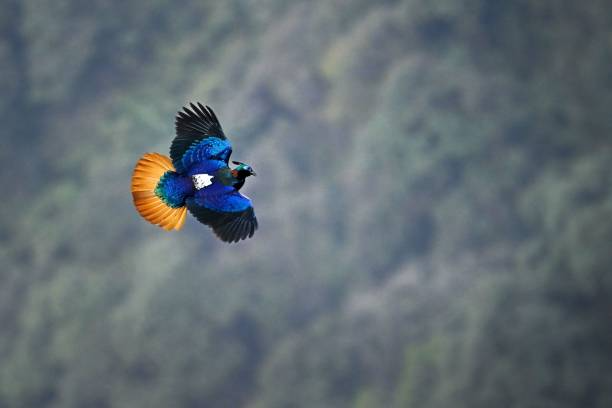
Habitat
The Monal is a stunning bird that calls the Himalayas home. You can spot them in alpine meadows, coniferous forests, and even in thickets of rhododendron. These birds are quite skilled at navigating steep, rocky terrains, often seen perched on slopes, in grassy clearings, or along the edges of forests.
During the summer months, they venture up to subalpine regions where the vegetation is sparse. When winter rolls around, they migrate down to the lower forests, where food is more plentiful and the snow isn’t as deep.

Diet
Himalayan Monals are fascinating omnivores, feasting on a variety of foods that their high-altitude habitat offers. With their strong, curved beaks, they’re perfectly equipped to dig through soil and leaf litter in search of:
– Roots and tubers
– Seeds and grains
– Berries and fruits
– Insects like beetles, ants, and caterpillars
– Small invertebrates such as snails and worms
Their menu shifts with the seasons; during the warmer spring and summer months, they indulge in more insects, while in the chillier months, they primarily rely on plant material.
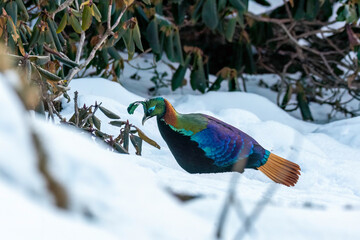
Behavior
Monals are primarily daytime creatures, coming alive in the early morning and late afternoon. They prefer to forage either solo or in small family groups, only gathering in larger flocks during the non-breeding seasons.
Despite their robust size, these birds are surprisingly nimble. When they feel threatened, they tend to run or fly uphill, quickly vanishing into the bushes or rocky cliffs. Their wings are strong, but they reserve flight for when it’s absolutely necessary, as soaring at high altitudes can be quite energy-draining.
These birds are also quite vocal. Males emit a sharp, flute-like whistle, especially during courtship or when they sense danger. These calls resonate through the mountain valleys, helping them communicate over vast distances.
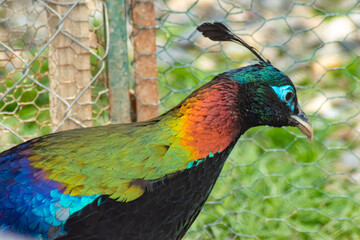
Lifespan
When it comes to their lifespan, Himalayan Monals in the wild usually live around 10 to 12 years. However, this can vary based on their environment and the threats they face from predators. In a controlled setting, where they receive proper care, these beautiful birds can live a bit longer, sometimes reaching up to 15 years.
Reproduction and Lifecycle
Himalayan Monals have a unique breeding cycle that follows the seasons. It kicks off in spring when the weather warms up and the snow starts to melt. During this period, the males really step up their game, becoming more vocal and visible as they try to attract females.
Once mating occurs, the female takes charge of nesting and brooding. She carefully selects a hidden spot to lay her 3 to 5 eggs, which she incubates all by herself for about 27 to 29 days.
After the chicks hatch, they stick close to their mother, who teaches them the ropes on foraging and how to stay safe from predators.
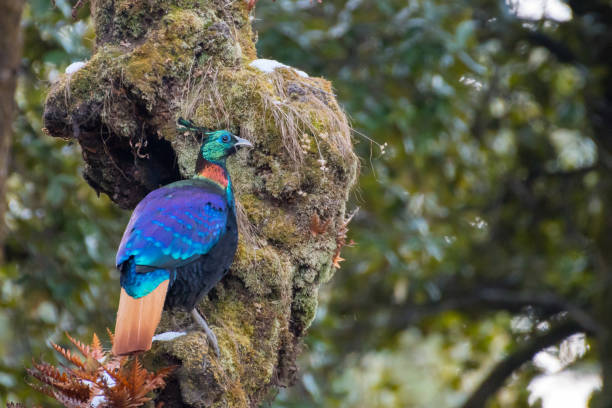
Predators
Himalayan Monals are quite skilled at blending into their surroundings and making a quick getaway. However, they still have to watch out for a variety of predators, including:
– Snow leopards
– Himalayan wolves
– Red foxes
– Large raptors, like eagles and hawks
– Feral dogs and human hunters
Their eggs and chicks are especially at risk from smaller carnivores and birds of prey.
Nest
The Monal’s nest is a simple, shallow dip in the ground, often tucked away under a bush, a log, or nestled among rocks. It’s cozy, lined with soft materials like grass, moss, and feathers to keep it warm.
Females choose nesting sites that provide good cover while still being close to food sources. They also remain very still to avoid drawing attention to themselves while they incubate their eggs.

Adaptations
Life in the Himalayas is no walk in the park, and the Monal is perfectly designed to thrive in this challenging environment:
– Dense plumage: Acts like a cozy blanket, keeping them warm in the freezing cold.
– Camouflaging coloration (females): Helps them stay under the radar while nesting.
– Strong legs and claws: Ideal for digging up food from the frozen ground.
– Excellent vision and hearing: Allows them to spot predators before it’s too late.
– Flight adaptation: With powerful breast muscles and broad wings, they can make quick, steep ascents.
These remarkable adaptations truly make the Himalayan Monal a champion of mountain survival.
Mating Season
- The mating season kicks off in April and stretches all the way through June, coinciding with the beautiful Himalayan spring. This is the time when food is abundant, and the last remnants of harsh snow have finally melted away.
- During this vibrant season, male animals really turn up the charm, showcasing their best moves to attract a mate. They do this by:
- Fanning out their tails and wings.
- Puffing up their feathers to look more impressive.
- Dancing around and singing to catch the attention of potential partners.
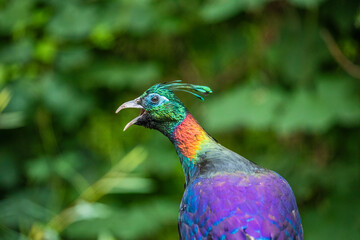
Breeding
Breeding is a fascinating process that begins after courtship, with copulation leading to the female searching for a suitable nesting spot. She typically lays between 3 to 5 buff-colored eggs, usually one each day. The female takes on the responsibility of incubating the eggs all by herself, and her natural camouflage helps her remain hidden from potential threats.
When the chicks hatch, they do so at the same time and stay close to their mother for several weeks. As they grow, around 8 to 10 weeks old, they start to look more like adult birds and gradually become more independent.
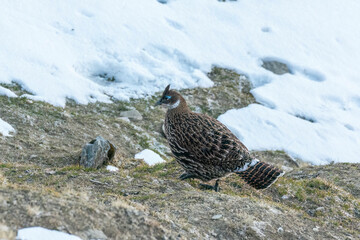
Interesting Facts
- National bird of Nepal: With its vibrant feathers and connection to the mountains, it truly embodies the spirit of the region.
- It’s named after Lady Impey, the wife of British Chief Justice Elijah Impey, who was the first to keep these beautiful birds in captivity.
- After the mating season, male birds shed their feathers, resulting in a temporary dullness until they regain their vibrant plumage in the spring.
- Cultural Symbol: This bird features prominently in many local folktales and dances, showcasing its significance in the culture.
- In Himachal Pradesh, India, it’s common to see feathers from this bird in traditional hats, although this practice is now being discouraged.
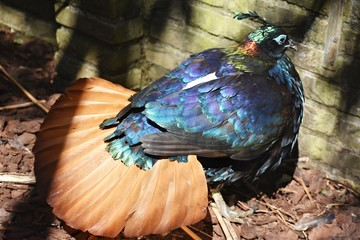
Conservation Status
- When it comes to conservation status, the Himalayan Monal is currently classified as Least Concern (LC) on the IUCN Red List. While that’s a bit of good news, this beautiful bird still faces some serious challenges, including:
- – Habitat loss from deforestation and the impact of tourism
- – Illegal hunting for its meat and stunning ornamental feathers
- – Disturbance caused by human encroachment
Final Thoughts
The Himalayan Monal isn’t just a stunning bird; it’s a vibrant symbol of the Himalayas. With its dazzling colors and resilient spirit, the Monal holds a special place in the hearts of the local culture. It captivates naturalists, trekkers, and conservationists alike.
In today’s world, where biodiversity faces serious threats, it’s crucial that we celebrate and safeguard species like the Monal. They serve as a powerful reminder of the incredible life that flourishes, even in the most challenging environments.

